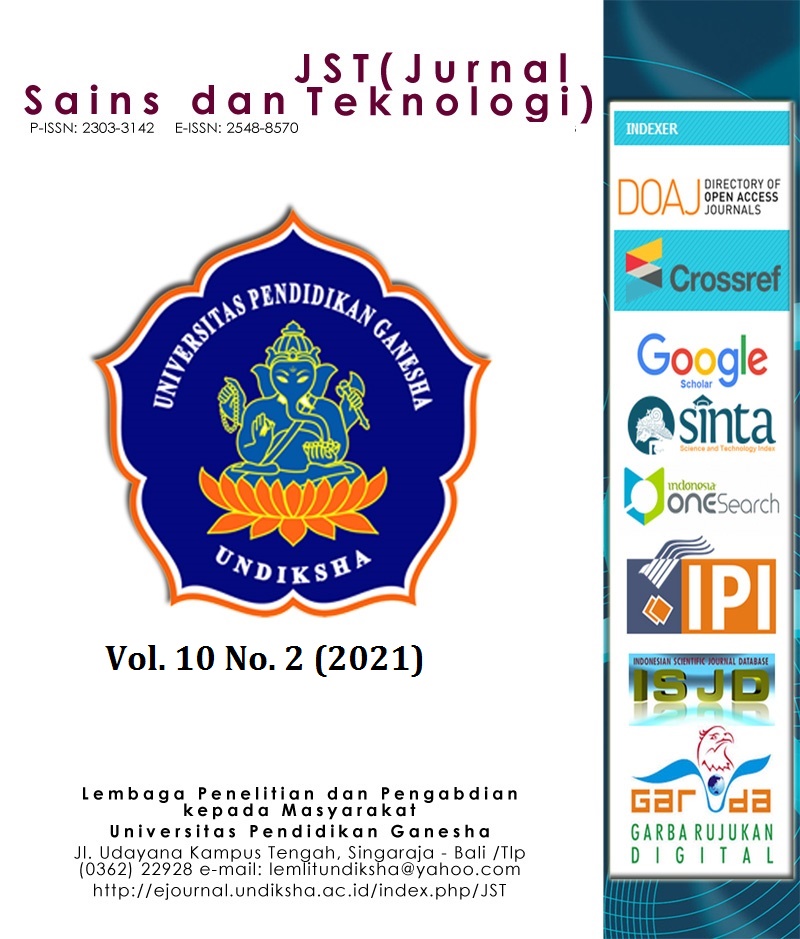UNDIKSHA VIRTUAL ASSISTANT (SHAVIRA): INTEGRATION FREQUENCY ASKED QUESTION WITH RASA FRAMEWORK
DOI:
https://doi.org/10.23887/jstundiksha.v10i2.39863Keywords:
Shavira, Chatbot, Rasa FrameworkAbstract
Nowadays, the implementation of chatbots in information systems is getting popular to increase user experience. In our previous research, we developed Undiksha Virtual Assistant (Shavira). Shavira is a knowledge management system (KMS) as Frequency Asked Question (FAQ) system to facilitate users to get an answer about their questions. The challenge on the existing Shavira system is that the users must open a website and type queries to get a list of answers. The text query must match with the keyword in systems. To address this problem and to avoid cognitive load, in this research we implemented a chatbot in Shavira. The purpose of the chatbot implementation in Shavira is to make information easier to be accessed and to increase user experience. The users can ask a question in natural language and get an answer immediately on their chat application such as: Telegram, Facebook, or Messenger. We used Rasa Framework as a chatbot engine in Shavira. Rasa Framework is an open-source virtual assistant engine based on artificial intelligence. The challenge in conducting this research is in integrating the existing FAQ system with Rasa Framework. This research consists of four phases, they are: adaptation data structure in the existing FAQ with data structure requested by Rasa framework, data integration and mapper, and evaluation. The result of this research is a new Shavira that is integrated with a chatbot and can be accessed from chat applications such as Telegram. We evaluated the accuracy of Shavira powered by Rasa Framework with ten topics about academic information. The results showed that the accuracy of Shavira is 90%. We also evaluated the usability of Shavira with Software Usability Scale (SUS) Questionnaire. The usability evaluation showed that Shavira satisfied users with value 81 (threshold 68) and categorized Excellent, Acceptable and Prometer.
References
Almansor, E. H., & Hussain, F. K. (2020). Survey on Intelligent Chatbots: State-of-the-Art and Future Research Directions. Advances in Intelligent Systems and Computing, 993(August 2019), 534–543. https://doi.org/10.1007/978-3-030-22354-0_47
Androutsopoulou, A., Karacapilidis, N., Loukis, E., & Charalabidis, Y. (2019). Transforming the communication between citizens and government through AI-guided chatbots. Government Information Quarterly, 36(2), 358–367. https://doi.org/10.1016/j.giq.2018.10.001
Cahn, J. (2017). CHATBOT : Architecture , Design , & Development. University of Pennsylvania.
Deepika, N. M., Bala, M. M., & Kumar, R. (2021). Design and implementation of intelligent virtual laboratory using RASA framework. Materials Today: Proceedings, xxxx, 1–5. https://doi.org/10.1016/j.matpr.2021.01.226
Jeff Sauro. (2011). Measuring Usability with the System Usability Scale (SUS). Measuringu. https://measuringu.com/sus/
Jiao, A. (2020). An Intelligent Chatbot System Based on Entity Extraction Using RASA NLU and Neural Network. Journal of Physics: Conference Series, 1487(1). https://doi.org/10.1088/1742-6596/1487/1/012014
Rasa. (2021). Introduction to Rasa Open Source. https://rasa.com/docs/rasa/
Resika Arthana, I. K., Dantes, G. R., Dewi, L. J. E., Setemen, K., & Marti, N. W. (2021). PENGEMBANGAN PROTOTYPE FREQUENTLY ASKED QUESTION (FAQ) UNDIKSHA DENGAN PENDEKATAN USER CENTERED DESIGN. Jurnal Pendidikan Teknologi Dan Kejuruan, 18(1), 77. https://doi.org/10.23887/jptk-undiksha.v18i1.32141
Sauro, J. (2018). 5 Ways to Interpret a SUS Score. Measuringu. https://measuringu.com/interpret-sus-score/
Sharfina, Z., & Santoso, H. B. (2016). An Indonesian adaptation of the System Usability Scale (SUS). 2016 International Conference on Advanced Computer Science and Information Systems (ICACSIS), 1566(1), 145–148. https://doi.org/10.1109/ICACSIS.2016.7872776
Singh, A., Ramasubramanian, K., & Shivam, S. (2019). Introduction to Microsoft Bot, RASA, and Google Dialogflow. In Building an Enterprise Chatbot (pp. 281–302). Springer.
Windiatmoko, Y., Rahmadi, R., & Hidayatullah, A. F. (2021). Developing Facebook Chatbot Based on Deep Learning Using RASA Framework for University Enquiries. IOP Conference Series: Materials Science and Engineering, 1077(1), 012060. https://doi.org/10.1088/1757-899x/1077/1/012060
Downloads
Published
How to Cite
Issue
Section
License
Authors who publish with the Jurnal Sains dan Teknologi (JST) agree to the following terms:
- Authors retain copyright and grant the journal the right of first publication with the work simultaneously licensed under a Creative Commons Attribution License (CC BY-SA 4.0) that allows others to share the work with an acknowledgment of the work's authorship and initial publication in this journal.
- Authors are able to enter into separate, additional contractual arrangements for the non-exclusive distribution of the journal's published version of the work (e.g., post it to an institutional repository or publish it in a book), with an acknowledgment of its initial publication in this journal.
- Authors are permitted and encouraged to post their work online (e.g., in institutional repositories or on their website) prior to and during the submission process, as it can lead to productive exchanges, as well as earlier and greater citation of published work. (See The Effect of Open Access)
















